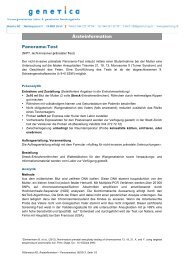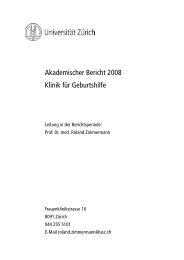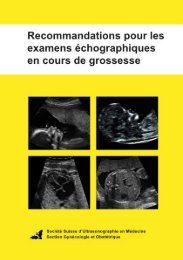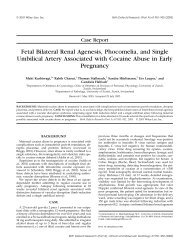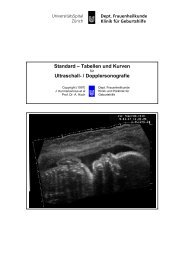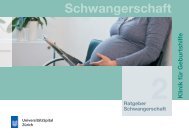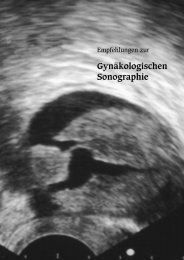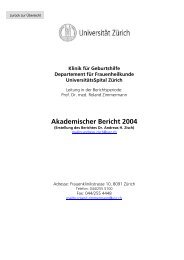Akademischer Bericht 2005 - Geburtshilfe - UniversitätsSpital Zürich
Akademischer Bericht 2005 - Geburtshilfe - UniversitätsSpital Zürich
Akademischer Bericht 2005 - Geburtshilfe - UniversitätsSpital Zürich
Sie wollen auch ein ePaper? Erhöhen Sie die Reichweite Ihrer Titel.
YUMPU macht aus Druck-PDFs automatisch weboptimierte ePaper, die Google liebt.
Professur/Forschungsbereich: Zisch, Andreas<br />
Risks of Long-QT syndrome in the Neonate<br />
Evaluation eines möglichen (dosisabhängigen) Zusammenhangs zwischen einer Methadonsubstitution<br />
zur Behandlung der Opiatabhängigkeit während der Schwangerschaft und dem Auftreten von QT-<br />
Verlängerungen im EKG des Neugeborenen.<br />
01.08.<strong>2005</strong>-28.02.2007<br />
Professur/Forschungsbereich: Zisch, Andreas<br />
Screening for hemoglobinopathies in pregnancy.<br />
01.01.2003-31.12.2006<br />
Professur/Forschungsbereich: Zisch, Andreas<br />
Selective use of erythropoietin (rhEPO) and iron sucrose in severe postpartum anaemia with special<br />
emphasis on the postpartal inflammatory reaction<br />
With a prevalence of 4-10% the postpartum anaemia is a main reason of morbidity of young women.<br />
Reasons for this are not only the blood loss but also the depletion of the iron stores during pregnancy, the<br />
loss of the mobil iron reservoir postpartum and the elevated inflammatory parameters influencing the iron<br />
metabolism. It is known that especially operative delivery leeds to a systemic inflammatory response. In<br />
former studies we were able to show a suppressed erythropoietin production and inadaequate response<br />
to rhEPO. The aim of this study is to determine, whether women with severe bleeding anaemia (Hb < 8.5<br />
g/dL) show suppressed EPO levels due to enhanced inflammatory response and how they profit of an<br />
additional rhEPO therapy. Parameters as erythrocyte and reticulocyte indices, serum iron, transferrin,<br />
ferritin, soluble transferin receptors, erythropoietin, CRP, IL-6, IL-8 and Neopterin where analysed on<br />
day 1, 4, 8, and 15.<br />
01.03.1999-31.05.<strong>2005</strong><br />
Professur/Forschungsbereich: Zisch, Andreas<br />
Selective use of erythropoietin (rhEPO) in anemic pregnant women with heterozygous form of hemoglobinopathies<br />
01.02.2004-31.08.<strong>2005</strong><br />
Professur/Forschungsbereich: Zisch, Andreas<br />
Selective use of recombinant human EPO in pregnant patients with anaemia, non responsive to iron<br />
therapy only (oral and parenteral) or with severe anaemia at diagnosis<br />
Introduction: We intend to examine a new therapy regimen for the use of parenteral iron sucrose and<br />
human recombinant erythropoietin (rhEPO) in pregnancy to women with a proven iron deficiency anaemia<br />
(IDA) [ferritin < 15 g/L, CRP = 10 mg/L]. For controlling the benefit we measure beside the classical<br />
parameters as erythrocyte and reticulocyte indices, serum iron, transferrin, ferritin, CRP and erythropoietin<br />
level, in addition two new parameters of iron diagnostic, neopterin and serum transferrin receptors<br />
(s-TfR). Neopterin is released from macrophages when cellular immune resistance is activated by cytokines.<br />
It is considered an indirect marker for iron metabolism disorders. The s-TfR is a new parameter<br />
which is purported to detect iron deficiency. The combination of both neopterin and s-TfR might result<br />
in improved diagnosis of the iron status, respectively, of anaemia, and thus also influence the therapy<br />
strategy. summary: To examine (1) a new therapy regimen women are an indicator of insufficient iron<br />
mobilisation /erythropoiesis, and (3) how reliably the s-TfR detect IDA in pregnancy.<br />
01.01.1998-31.05.<strong>2005</strong><br />
Professur/Forschungsbereich: Zisch, Andreas<br />
Side-effects of Adalat Tokolysis<br />
01.01.2004-31.03.<strong>2005</strong><br />
Professur/Forschungsbereich: Zisch, Andreas<br />
Simulation of course of delivery with ’Ana-Pelvis’ computer program using ultrasound fetal biometry and<br />
MRI pelvimetric data.<br />
01.06.2003-30.06.2006<br />
Klinik für <strong>Geburtshilfe</strong><br />
<strong>Akademischer</strong> <strong>Bericht</strong> <strong>2005</strong><br />
19



